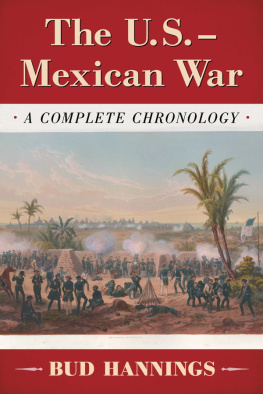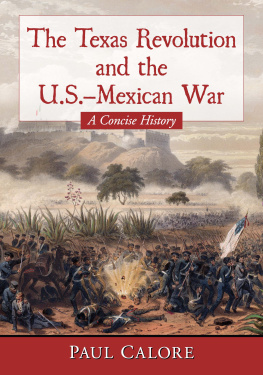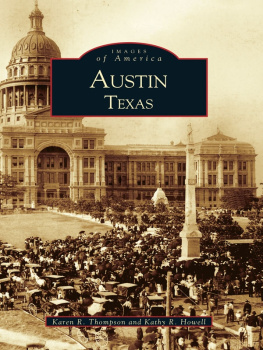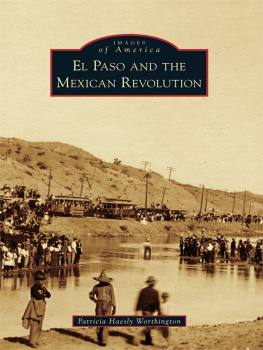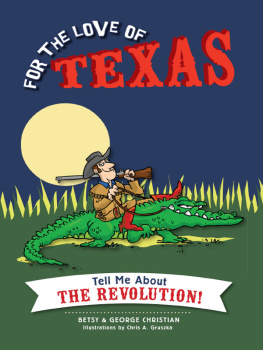Texian Iliad

BATTLE OF THE ALAMO, MARCH 6, 1836
Texian Iliad
A MILITARY HISTORY OF THE TEXAS REVOLUTION, 1835 1836
Stephen L. Hardin
Illustrated by Gary S. Zaboly

To Mom and C.W.
for always being there
my gratitude
S.L.H.
Copyright 1994 by the University of Texas Press
All rights reserved
Printed in the United States of America
Seventh paperback printing, 2008
Requests for permission to reproduce material from this work should be sent to:
Permissions
University of Texas Press
P.O. Box 7819
Austin, TX 78713-7819
www.utexas.edu/utpress/about/bpermission.html
The paper used in this book meets the minimum requirements of
ANSI/NISO Z39.48-1992 (R1997) (Permanence of Paper).
Library of Congress Cataloging-in-Publication Data
Hardin, Stephen L., 1953
Texian iliad : a military history of the Texas revolution, 1835-1836 /
Stephen L. Hardin ; illustrated by Gary S. Zaboly. 1st ed.
p. cm.
Includes bibliographical references and index.
ISBN 978-0-292-73102-8 (pbk.)
1. TexasHistoryRevolution, 1835-1836Campaigns. I. Title.
FF390.H29 1994
976.403dc20
94-1564
THUS THE NEW EPIC OF TEXAS, the chronicles so recently written and the legends so vibrantly alive with yesterdays happenings, exerts upon the tourist who wanders there the magic of a new lore and of an unmatched poetry. The names of the Milams, Travises, Fannins, and Bowiesthose popular heroes of the Texian Iliadrecall to mind repeatedly and amazingly the most stalwart heroes of Homer; the fortnight of the siege of the Alamo can scarcely be paralleled by any days of the ten-year siege of Troy.
FREDERIC GAILLARDET, 1839
WITH THE EXCEPTION of the infamous massacres of the Alamo and Goliad, and considering the Bobadil terms in which it has been spoken of, [the Texan war] is almost burlesque.
THEODORE SEDGWICK, 1844
CONTENTS
ILLUSTRATIONS
FIGURES
Battle of the Alamo FRONTISPIECE
MAPS AND DIAGRAMS
PHOTOGRAPHS AND PORTRAITS
PREFACE
Scholarly conflicts over the Texas Revolution are at times as bitter as the war itself and almost always of longer duration. More traditional historians view it as a heroic struggle of determined Americans against overwhelming odds. Deconstructionists view it as a shameless land grab, a scheme concocted by the slaveocracy, that marked the beginning of a particularly unpleasant phase of Manifest Destiny. The first view is boastfully romantic; the second tends to dismiss legitimate as well as fallacious elements of older interpretations.
My purpose is not to review old fights or to pick new ones. A perfunctory glance at the bibliography will reveal that much solid work has been done on the Texas revolt of 1835-1836. What was lacking was a careful analysis of the military aspects of the war. Certainly books abound on the Alamo and San Jacinto, but the glare of those shining moments has obscured the less famous, but nonetheless, important incidents. The story needs to be told in full.
Political events have been discussed only to the extent that they had a bearing on the actions of the soldiers in the field. Professor Paul Lacks recent study, The Texas Revolutionary Experience: A Political and Social History, 1835-1836, precludes the need for another political history of the revolt for the foreseeable future. I have, nevertheless, listed several of the earlier political treatments in the bibliography for those whose curiosity strays in that direction.
My reasons for offering a military narrative go beyond a desire to illuminate the causes of the Revolution. Students of Texas history and nineteenth-century warfare have generally failed to grasp its lessons or view the conflict within a wider context. Professor Archie P. McDonald, to cite but one, laments that Texas has no Hannibal, no Napoleon to formulate or demonstrate great tactical or strategic truths. It contributes no infantry maneuvers or artillery innovations of lasting significance. Its only real value is moral.
Dr. McDonald is correctto a point. Compared to the Napoleonic wars that preceded it and the Mexican and Civil wars that followed in its wake, the Texas revolt appeared trifling indeed. Even so, for the student of military history, the fact that the war was sandwiched between these pivotal events renders it all the more significant.
Tactics during the 1830s underwent a remarkable transition. Countries such as France, which had previously relied on linear tactics and smoothbore muskets, began to experiment with open order formations and skirmishers armed with rifles. Although far from being in the forefront of tactical innovation, the Texas and Mexican forces were not totally unaware of military precedents. As early as 1824, the Mexican army established tirailleurs in rifle companies. That same year a proportion of men in both regular and militia companies were slated as light troops. While the image of the American leatherstocking and his long rifle has been popularized to the point of stereotype, it is nonetheless true that many Texas militiamen were highly proficient with that lethal firearm. Because they lacked the training and discipline to stand in the line of battle and perform the intricate maneuvers such formations required, Americans also fought as light infantry. In Europe commanders were trying to promote individual initiative among their riflemen; on the American frontier independent action was almost second nature. The point is not that the soldiers who waged the war in Texas were trained professionals establishing doctrine, but rather that they unwittingly explored some of the same tactical modes that more sophisticated European commanders were at the same time investigating by design.
Topography played a part. Time after time, Texians, reared in the traditions of the North American woodlands, sought the protection of natural cover. When they did, they could be relatively certain that the precision of their rifles could keep the enemy at bay. Much of the war, however, was waged on the grassy prairies of the Rio Grande Plain, where trees and other natural cover were rare. Here, the Mexicans with their superior equestrian skills were formidable.
Geography also influenced the conduct of the war. By their presence in the fertile Brazos River bottom and the pine woods of East Texas, the Americans had rendered those regions cultural, as well as geographical, extensions of the North American woodlands. The plains south of the Colorado River were still predominantly the province of the tejano ranching culture. As cultural geographer D. W. Meinig observed, It was not merely accidental that the two great Anglo-American disasters, at the Alamo and Goliad, took place beyond the margins of Anglo-American colonization, while their final triumph, at San Jacinto, took place deep within a country they had made their own.
I am a Texan. That fact, many insist, precludes any objective treatment of the Mexicans; I hope to convince them otherwise. A chauvinistic tone has admittedly marred many earlier studies published north of the Rio Grande. Whenever possible, Mexican sources were consulted, and I have attempted to understand and explain the monumental problems faced by the Mexican forces. The behavior of the individual soldado left a legacy of valor of which Mexicans should be proud and that North Americans should acknowledge.
Next page

